-
Adafruit IoT Monthly: The S in IoT is for Security, Amazon announces Sidewalk and more!
Adafruit IoT Updates
Adafruit IO Update: Set icons on your gauge and text blocks!

Settable Icons and decimal controls are now available for your Adafruit IO Gauge and Text elements! - Visit your Adafruit IO Dashboard to try it out now
New IoT Hardware: TinyPICO ESP32 Development Board

The smallest, most feature-rich ESP32 dev board has arrived at Adafruit…
There are quite a few ESP32 boards on the market, but they all require you to compromise on one or more features. Some don’t have on-board battery management, while some do but they don’t have low deep sleep current. Others have great low-power modes, but are large and not breadboard-friendly, and none of them have extra RAM unless you go for a more expensive and larger WROVER-powered board. We just weren’t happy with the status quo - we wanted to have our cake and eat it too! So we designed the smallest un-compromising ESP32 development board in the world, and then went a step further and gave it 4 MB of extra RAM, an on-board RGB LED, and more juice with a 700 mA 3.3 V regulator.
Visit the product page to learn more…
Coming soon: BrainCraft HAT for Raspberry Pi 4

We’ve started to design a BrainCraft HAT for Raspberry Pi and other Linux computers. It has a 240×240 TFT display for inference output, slot for camera connector cable for imaging projects, a 5 way joystick and button for UI input, left and right microphones, stereo headphone, stereo speaker out, three RGB DotStar LEDs, two 3 pin STEMMA connectors on PWM pins so they can drive NeoPixels or servos, and Grove/STEMMA/Qwiic I2C port. This should let people build a wide range of audio/video AI projects while also allowing easy plug-in of sensors and robotics! The BrainCraft has a wide variety of connectivity methods:
Wireless flexibility: WiFi, cellular, Bluetooth LE Works with adafruit.io, of course!
Visit the product page to learn more…
IoT Projects
a Hello World for ESP-NOW

ESP-NOW is “yet another protocol developed by Espressif, which enables multiple devices to communicate with one another without using Wi-Fi”. If you want to try out ESP-NOW right now, Jake Wachlin built an ESP-NOW example with example code on GitHub (you’ll need two ESP32 devices). He also took an extra step and performed latency and reliability testing from his city apartment (a very busy 2.4GHz spectrum).
Smart Outlet with MKR WiFi1010 and Adafruit IO

Smart plug to control a lamp using Google’s voice assistant with an Arduino MKR WiFi 1010 and a 5V relay - Hackster.io
Upgrade the ESP32 Firmware on your AirLift

Adafruit ships a variety of products which use the ESP32 as a WiFi co-processor with a variant of the Arduino nina-fw core. If you want to keep the firmware on your ESP32 WiFi co-processor up-to-date, you’ll need to update the firmware on the ESP32. This guide will teach you how to to turn your board into a USB-to-Serial converter to flash new firmware to your ESP32 – no extra hardware required! - Adafruit Learning System
Live-stream anywhere with an ESP32-CAM
 Set up a streaming web server with face recognition and detection in less than five minutes with Arduino IDE (we sell a similar ESP32 camera module here) - via Maker.Pro
Set up a streaming web server with face recognition and detection in less than five minutes with Arduino IDE (we sell a similar ESP32 camera module here) - via Maker.ProSet up Home Assistant with a Raspberry Pi
 Create your own secure, smart-home-hub with HASSio, MQTT, Node RED and More!
Create your own secure, smart-home-hub with HASSio, MQTT, Node RED and More!Home Assistant is an open source operating system for a localized Smart Home Hub. Basically it works like IFTTT or Samsung Smart Things, but without having to send your data out onto the internet. This means that you have total control over your data, limit the amount of internet traffic from your smart devices, and tighten up security.
Read the guide on the Adafruit Learning System…
Fried Desk Lamp Reborn: Rebuilding a device with connectivity
 Sean Boyce ran 220 Volts AC through his “fancy Xiaomi Smart Lamp”’s 12VDC transformer. He went about repairing it, but didn’t trust “installing another (potentially data-harvesting) app on [his] phone just to control a lamp] and thus wrote a protocol for the NodeMCU fan controller. - via HackADay
Sean Boyce ran 220 Volts AC through his “fancy Xiaomi Smart Lamp”’s 12VDC transformer. He went about repairing it, but didn’t trust “installing another (potentially data-harvesting) app on [his] phone just to control a lamp] and thus wrote a protocol for the NodeMCU fan controller. - via HackADayRunning TensorFlow Lite Object Recognition on the Raspberry Pi 4
 Want to up your robotics game and give it the ability to detect objects? Maybe implement a security camera that can see and identify certain items? Now that the Raspberry Pi is fast enough to do machine learning, adding these features is fairly straightforward. Take this guide a step further and interface image recognition with your favorite cloud IoT service. - via Adafruit Learning System
Want to up your robotics game and give it the ability to detect objects? Maybe implement a security camera that can see and identify certain items? Now that the Raspberry Pi is fast enough to do machine learning, adding these features is fairly straightforward. Take this guide a step further and interface image recognition with your favorite cloud IoT service. - via Adafruit Learning SystemIoT Anti-Addiction Lockbox
 Lock away your vices in an IoT anti-addiction lockbox. Aside from the internet-controlled lock, this box can detect the physical presence of an item using an ultrasonic sensor and a digital scale. - via Instructables
Lock away your vices in an IoT anti-addiction lockbox. Aside from the internet-controlled lock, this box can detect the physical presence of an item using an ultrasonic sensor and a digital scale. - via InstructablesMonitoring 3D Printer Filament Humidity with low power radio

Dr. Scott M. Baker built small, wireless sensor nodes, to verify the storage of vacuum sealed “PrintDry” 3D Filament Storage containers. The sensor nodes transmit data using low-powered SYN115 radio modules, which are received by a Raspberry Pi connected to the internet. - via smbaker.com
Indoor Air Quality Monitor with PyPortal and Particle

Measuring the air quality in a your region can help you understand the world around you,
More than two billion people worldwide continue to depend on solid fuels, including fuels and coal, for their energy needs. Cooking and heating with fuels on open fires or traditional stoves result in high levels of indoor air pollution. Indoor smoke contains a range of health-damaging pollutants, such as small particles and carbon monoxide, and particulate pollution levels maybe 20 times higher than accepted guideline values.
This is a pretty through build - a Particle Argon acts as an environmental monitor, sends data to Particle Cloud, is logged to long-term Google Firebase storage, and displayed locally on a PyPortal. - via electromaker.io
eAgar: Large-scale plant monitoring with LoRa

eAgar is a system for monitoring conditions of agriculture fields. Each sensor device is plug-and-play (just initial device provisioning is required) thanks to using LoRa communication to an outdoor multi-channel LoRa gateway.
With more information from fields, farmers can predict appearance of disease and prevently treat their plants. That will help them to reduce costs, reduce damages on plants, increase quality of crops and increase yields. Using chemical agents on clever way, in smaller quantities, will enable to customers get healthier food.
Read more about this project on Hackaday.io…
Smart Gate - DIY’ing Secure Facility Access

Michael is building a smart security control gate to control who accesses the Institute Univeritaire De La Cote in Cameroon. - via Hackaday.io
Around the Internet - IoT News and Links
The “S” missing from IoT is for Security

Digi-Key and Adafruit have teamed up to present answers to the idiosyncrasies of properly connecting things to the internet or IoT – (AKA Internet of Things). When you see that the “S” is missing from IoT, that is because there is a large amount security missing from modern day internet connected devices. - Watch “All the Internet of Things: The S in IoT is for Security” on Youtube
Amazon Sidewalk: a new 900MHz Protocol

Amazon is taking a plunge into the Low-Power IoT (LPIOT) pool and announced they’re working on a protocol named Amazon Sidewalk. This protocol sits on the 900MHz frequency band and will link IoT devices together. Much like LoRaWAN, it supports secure OTA updates but also geolocation. There’s not a lot of information about this protocol, it won’t be out for a while (at least a year for the SDK) and the first device will be named Fetch is a locator which can clip onto your dog’s collar. - via Amazon DayOne This protocol does have it’s skeptics though - Kyle Wiggers wrote an article on VentureBeat detailing that he feels “Amazon Sidewalk’s success is Anything but Assured” - via VentureBeat
ATECC608 Cryptographic Co-Processor gets a CircuitPython Library

The ATECC608 is the latest crypto-auth chip from Microchip, and it uses I2C to send/receive commands. Once you ‘lock’ the chip with your details, you can use it for ECDH and AES-128 encrypt/decrypt/signing. There’s also hardware support for random number generation, and SHA-256/HMAC hash functions to greatly speed up a slower micro’s cryptography commands.
We’ve updated this guide to include instructions for wiring and using our new Adafruit CircuitPython ATECC library. This library can interface with your ATECC608 breakout and perform AES-128 signing, random number generation, SHA-256 hashing, Certificate Signing Request generation and more!
Follow along with the Adafruit Learning System Guide here…
NEW Book: Learning IoT with Python and Raspberry Pi

A new book on learning IoT using a Raspberry Pi with Python offers a full IoT curriculum for a person or a classroom. Some of the book’s contents include important internet-connected topics such as:
- Control a servo using classes
- Upload data to the cloud
- Learn how to access a database using SQL statements
- Deploy a home monitor system that uses the Raspberry Pi Camera and a PIR sensor circuit. Upload pictures to a web server in the cloud and access the pictures on a web page.
- Control a robot using a multi-threaded application
Pre-order the book on Barnes and Noble’s website…
Comparing the ESP32 to the ESP32-S2

With more ESP32-S2 engineering samples in the wild, maker.pro published an analysis comparing the ESP32 to the new ESP32-S2. Xose Pérez notes that:
With the new ESP32-S2, Espressif is trying to fill a gap between the ESP8266 and the ESP32, both in features and price. The ESP32-S2 is not an ESP32 killer. Instead, it’s more an ESP8266 killer.
RPiAPI: a Lightweight WSGI API for RPi GPIO
 Interact with your Raspberry Pi using RPiAPI - a Lightweight API built on top of RPI GPIO - via Hackaday.io
Interact with your Raspberry Pi using RPiAPI - a Lightweight API built on top of RPI GPIO - via Hackaday.ioWhat is Adafruit.IO?
Adafruit.io has over 14,000+ active users in the last 30 days and 830+ Adafruit IO Plus subscribers. Sign up for Adafruit IO (for free!) by clicking this link. Ready to upgrade? Click here to read more about Adafruit IO+, our subscription-based service. We don’t have investors and we’re not going to sell your data. When you sign up for Adafruit IO+, you’re supporting the same Adafruit Industries whose hardware and software you already know and love. You help make sure we’re not going anywhere by letting us know we’re on the right track.
-
Adafruit IO Update: More Useful Shared Feeds in Adafruit IO @adafruitio #IoT
Up until now you’ve been able to share feeds with other Adafruit IO makers, publishing and subscribing from our HTTP and MQTT APIs, but it’s been difficult (i.e., impossible) to actually use them anywhere else on the Adafruit IO site. That has changed!
We have added Adafruit IO shared feeds to feed listings on your main feeds page and on the dashboard block editor so you can now see all of the feeds you have access to when you’re browsing Adafruit IO. That means quick insight into feeds that were shared with you, the level of access you have (read or read and write) at a glance, and their latest values.
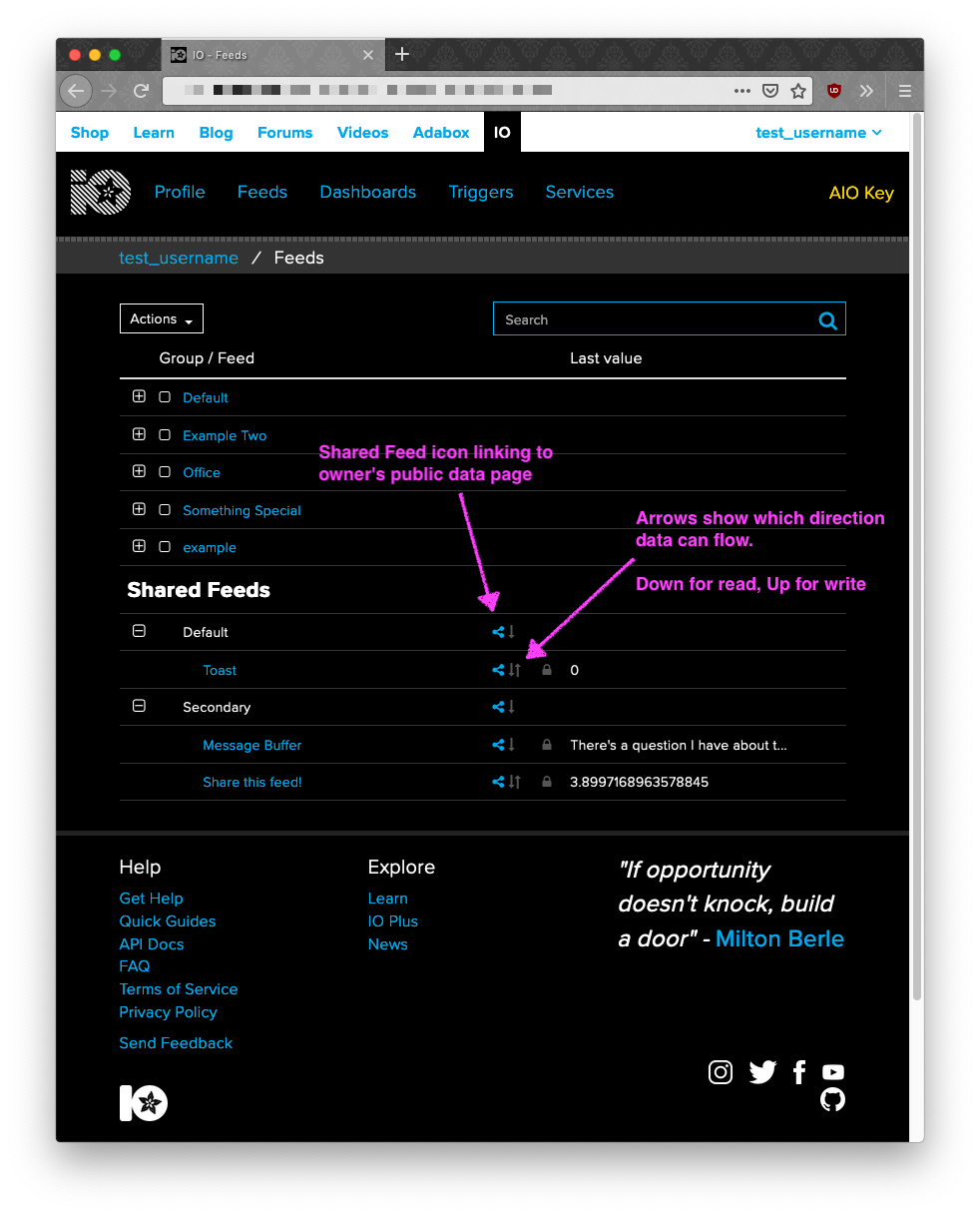
Shared feeds are listed at the bottom of your main feeds page.
We’ve also added shared feeds to the dashboard block editor so that you can build hybrid dashboards with feeds from multiple Adafruit IO accounts. Shared feeds get the same instant updates as feeds you own, and if you have read/write access to the shared feeds, you’ll be able to send data to them from dashboards you create.

Shared feeds are listed at the bottom on the “Select Feeds” screen of the block editor.
Please stop by the forums or our channel on the Adafruit Discord server and show us what you’re making or to reach out if you have any questions!
-
Adafruit IoT Monthly: Adafruit IO Updates, RGB Stream Deck Message Panel, and more
Adafruit IOT Updates
Adafruit IO Update: New User Interface!
 We’ve updated the Adafruit IO user interface to match recent changes on the Adafruit website and the Adafruit Learning System. Here’s a shortlist of changes:
We’ve updated the Adafruit IO user interface to match recent changes on the Adafruit website and the Adafruit Learning System. Here’s a shortlist of changes:- New User Interface!
- Reorganized menus
- Quick links to access your data faster
- New footer - the footer from adafruit.com was moved over. The new footer includes links to API documentation, forums, and the support page.
This is a pretty big update to the IO user interface, one that we hope makes it quicker to get around and easier to find what you’re looking for. Please stop by our channel on the Adafruit Discord server and reach out if you have any questions!
Read the full changelog with screenshots!.
New IoT LoRaWAN Hardware: The Things Indoor Gateway!
 Meet the affordable 8 Channel LoRa gateway from TTN, The Things Indoor Gateway! Simple name for a straight-to-the point product. It’s the new low cost, indoor multi-channel LoRaWAN gateway designed by The Things Network, so you know it will work perfectly with TTN. Make a free account, plug it in, follow the easy step-by-step installation instructions and you’ve got yourself a LoRaWAN to Internet gateway in under 5 minutes. No setup or usage fees.
Meet the affordable 8 Channel LoRa gateway from TTN, The Things Indoor Gateway! Simple name for a straight-to-the point product. It’s the new low cost, indoor multi-channel LoRaWAN gateway designed by The Things Network, so you know it will work perfectly with TTN. Make a free account, plug it in, follow the easy step-by-step installation instructions and you’ve got yourself a LoRaWAN to Internet gateway in under 5 minutes. No setup or usage fees.Visit the product page to learn more.
New IoT Hardware: M5Stick-C Pico
 Jam-packed with a Wi-Fi & Bluetooth powered ESP32, USB interface, Li-Poly battery and charge circuitry, 0.96” color TFT display, various sensors (IR transmitter, microphone, 6-DoF IMU sensor) all integrated inside, buttons, and more! You can plug Grove sensors into one end, or use the 0.1” header sockets on the other, to connect additional sensors or actuators. It’s perfect for making ultra-small IoT projects or wearables.
Jam-packed with a Wi-Fi & Bluetooth powered ESP32, USB interface, Li-Poly battery and charge circuitry, 0.96” color TFT display, various sensors (IR transmitter, microphone, 6-DoF IMU sensor) all integrated inside, buttons, and more! You can plug Grove sensors into one end, or use the 0.1” header sockets on the other, to connect additional sensors or actuators. It’s perfect for making ultra-small IoT projects or wearables.Visit the product page to learn more…
IoT Projects
Stream Deck controlled RGB Message Panel using Adafruit IO

Easily display status messages with a Stream Deck and an RGB Matrix Panel.
This project uses a custom Stream Deck plugin to communicate directly with the Adafruit IO REST API. It works by posting a specific value to a feed and each button will post a different value to the feed allowing you to easily change messages.
Read the guide on the Adafruit Learning System here.
PyPortal Daily UV Index Display
 UV is what gives you vitamin D and a tan… and a sunburn… and, well, skin cancer. It’s a case of a little being ok but too much being pretty bad. Like bacon. You can now check the UV index at a glance on your PyPortal.
UV is what gives you vitamin D and a tan… and a sunburn… and, well, skin cancer. It’s a case of a little being ok but too much being pretty bad. Like bacon. You can now check the UV index at a glance on your PyPortal.Read the guide on the Adafruit Learning System here.
PyPortal IoT Plant Monitor with Google Cloud IoT Core and CircuitPython
 Turn your black thumb into a green thumb by building an internet-enabled plant monitoring system by combining Google Cloud IoT Core with CircuitPython.
Turn your black thumb into a green thumb by building an internet-enabled plant monitoring system by combining Google Cloud IoT Core with CircuitPython.Read the guide on the Adafruit Learning System here.
Consumers Should Immediately - a live feed of recalled product info on a boot
 Named “Consumers Should Immediately…“, it displays a live data feed from The United States Consumer Product Safety Commission (USCPSC) to randomly display thousands of products recalled for reasons such as fire, electrocution, entrapment, choking and a variety of other unintended dangers. - ExtraSleepy.com.
Named “Consumers Should Immediately…“, it displays a live data feed from The United States Consumer Product Safety Commission (USCPSC) to randomly display thousands of products recalled for reasons such as fire, electrocution, entrapment, choking and a variety of other unintended dangers. - ExtraSleepy.com.3D Printed LoRA Remote

Via back7.co:
This is meant to be a simple remote control for LoRa-based robotics projects. It runs CircuitPython
Live Train Station Departure Sign for your Desk
 Build your own UK train station platform departure display (next train indicator) with live data using a Raspberry Pi Zero, OLED display and 3D printed case - a cool (and practical!) desktop gadget - balena.io
Build your own UK train station platform departure display (next train indicator) with live data using a Raspberry Pi Zero, OLED display and 3D printed case - a cool (and practical!) desktop gadget - balena.ioAround the Internet - IoT News & Links
 Ludzinc has been building a IoT Garage Door Opener since 2013, and blogged about Easier ESP development (learn from their four years of frustration). It’s an incredibly comprehensive post discussing everything from websockets to selecting proper hardware.
Ludzinc has been building a IoT Garage Door Opener since 2013, and blogged about Easier ESP development (learn from their four years of frustration). It’s an incredibly comprehensive post discussing everything from websockets to selecting proper hardware.
The OpenHAK is an open-source fitness tracker which can count your steps and measure your heart rate. Step counting is done by a Bosch BMI160, and the heart rate sensing is done with a Maxim MAX30101. The whole thing is driven and built around a Simblee BLE radio module.

Officially build an Alexa Gadget with your Raspberry Pi to control a RGB LED - Alexa on GitHub
 Pwavrobot is building a dual esp32 feather-format board, just for fun.
Pwavrobot is building a dual esp32 feather-format board, just for fun.
Icarus, a new IoT Board with the latest nRF91 integrates GPS and Cellular (LTE-M, MB-IoT) - Actinius

The Next Wave of IoT Bluetooth devices might not have batteries thanks to Bluetooth 5 and Energy Harvesting - EETimes
What is Adafruit IO?
Adafruit.io has over 14,000+ active users in the last 30 days and over 830+ Adafruit IO Plus subscribers. Sign up for Adafruit IO (for free!) by clicking this link.
Ready to upgrade? Click here to read more about Adafruit IO+, our subscription-based service. We don’t have investors and we’re not going to sell your data. When you sign up for Adafruit IO+, you’re supporting the same Adafruit Industries whose hardware and software you already know and love. You help make sure we’re not going anywhere by letting us know we’re on the right track.
-
Adafruit IO Update: New User Interface! @adafruitio #IoT
We have updated the Adafruit IO user interface to take advantage of recent changes to https://www.adafruit.com and https://learn.adafruit.com along with a batch of internal changes that improve the size of initial code downloaded when you visit the site–total script size was reduced by about 15%–and speed up the initial page load when you visit a page on https://io.adafruit.com.
The biggest change you’ll notice is a reorganization of our menus. The old menu from the left hand side of the screen is now split between a new header (top of page) with Adafruit-styled “flyout” menus linking to your pages within the site and a footer (bottom of page) with links to information about Adafruit IO.
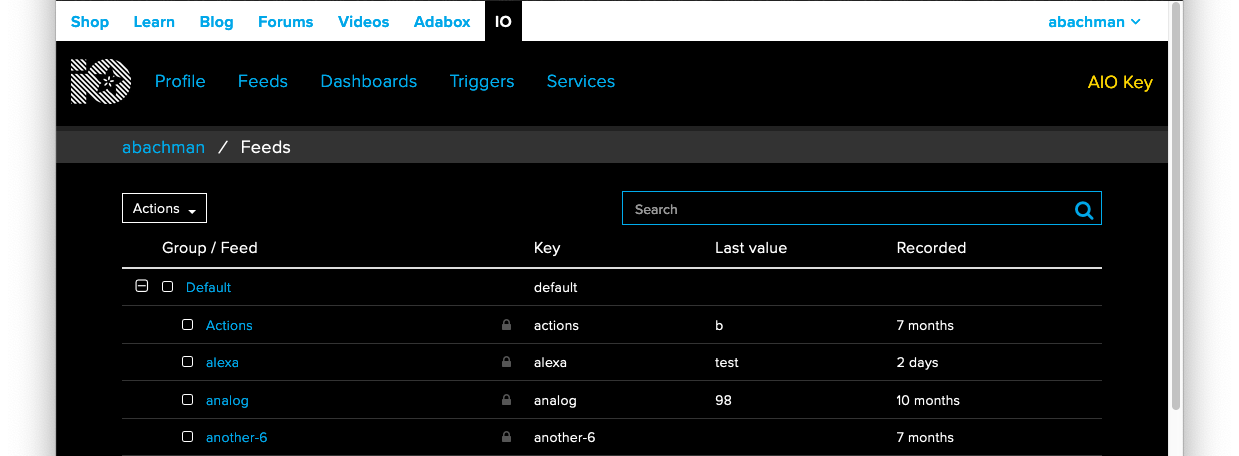
The header includes links to other Adafruit sites and to other pages in io.adafruit.com.
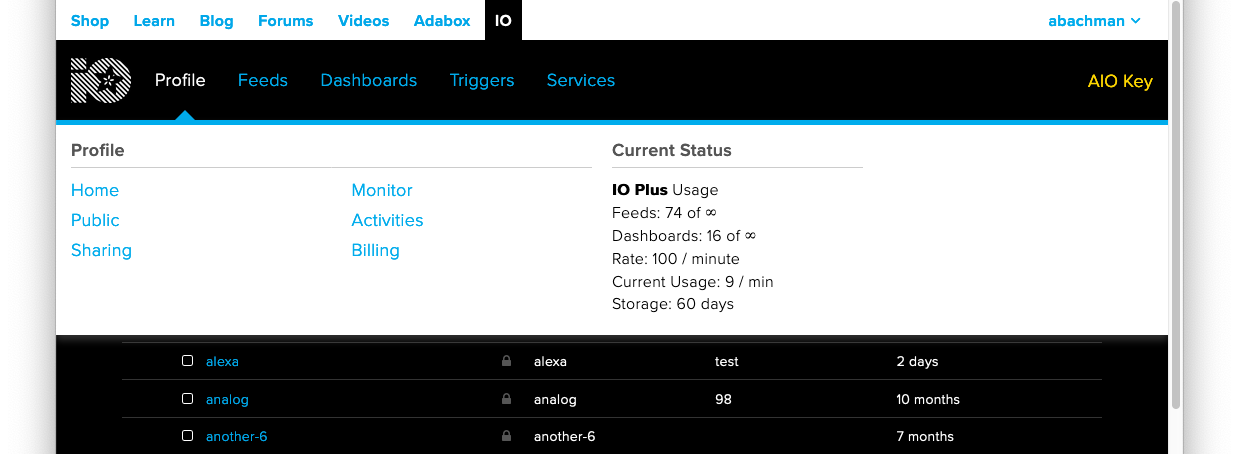
Click on a menu heading, like “Profile”, to show links to the rest of your data on Adafruit IO.
Quick links to your data
The new Feeds, Dashboards, and Triggers menus also include quick links to your most recently updated feeds, dashboards, and triggers.
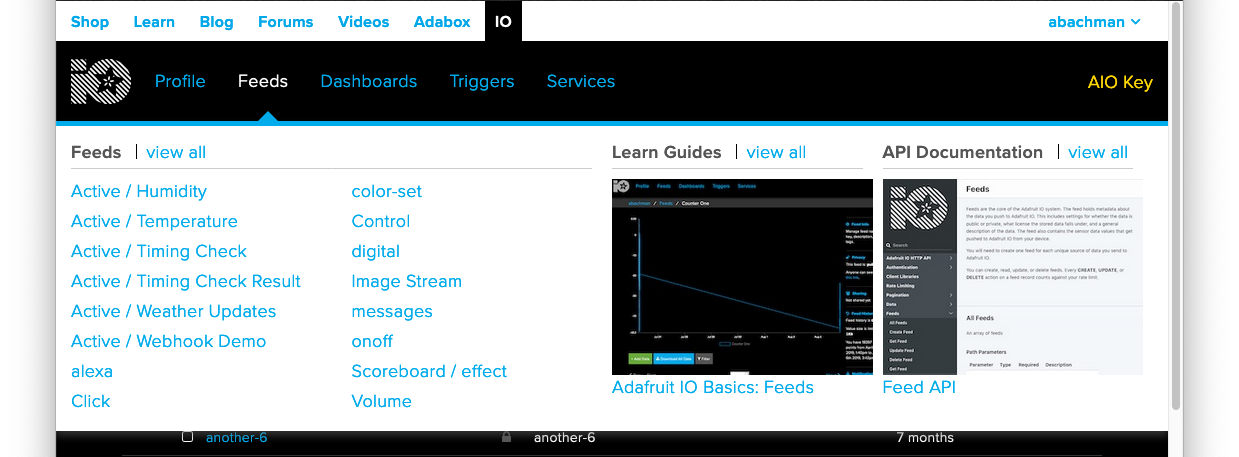
Footer quotes!
Finally, we’ve brought the footer from Adafruit over. It sits at the bottom of every page and is where you can find links to our support page, quick guides, API documentation, and the feedback form.
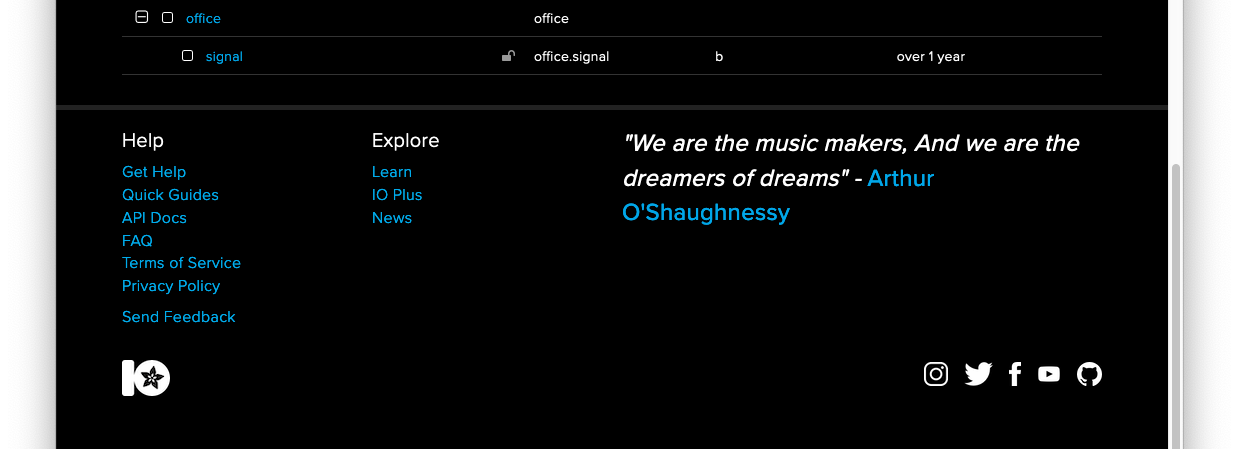
This is a pretty big update to the IO user interface, one that we hope makes it quicker to get around and easier to find what you’re looking for. Please stop by the forums or our channel on the Adafruit Discord server and reach out if you have any questions!
-
Adafruit IOT Monthly: MQTT Comes to CircuitPython, an Interactive IoT Airplane Sculpture and more!
Adafruit IOT Updates
MQTT comes to CircuitPython!

So, you have a CircuitPython project and want to connect it to the internet? You may want to consider adding MQTT to your project. MQTT is an extremely popular and lightweight protocol which can connect your project to the internet and quickly process network events. We’ve built a robust MQTT module for CircuitPython called CircuitPython MiniMQTT to quickly get you started connecting your projects to the internet and sending data around. Learn all about using MQTT with CircuitPython in on the Adafruit Learning System Guide here!
Adafruit IO CircuitPython Library UPDATE: MQTT!
 The Adafruit IO CircuitPython library has been updated with a new IO_MQTT class for accessing Adafruit IO’s MQTT Broker. We’ve included helpful methods for simplifying interactions with Adafruit IO over MQTT. Download the latest version of the Adafruit IO CircuitPython Library in the CircuitPython Bundle here and check out some examples which make use of the new MQTT class here.
The Adafruit IO CircuitPython library has been updated with a new IO_MQTT class for accessing Adafruit IO’s MQTT Broker. We’ve included helpful methods for simplifying interactions with Adafruit IO over MQTT. Download the latest version of the Adafruit IO CircuitPython Library in the CircuitPython Bundle here and check out some examples which make use of the new MQTT class here.New IoT Hardware: 8-Channel LoRa Gateway HAT with LoRa and GPS Antenna
 This LoRa HAT from RAK Wireless is capable of multi-channel, multi-node communication, all running in a non-intimidating, hackable Raspberry Pi environment. Unlike our basic LoRa gateway bonnet, this chipset can support all 8 channels, so it can handle multiple clients, on different LoRa channels, without having to do any code tweaks. Visit the product page fo the LoRa Gateway HAT here! Once you have your Internet-to-LoRa gateway set up with this kit, make LoRa nodes using our Feather line for easy deployment of sensor networks that run on battery power. We have guides about setting up LoRaWAN nodes using either Arduino OR CircuitPython on the Adafruit Learning System here.
This LoRa HAT from RAK Wireless is capable of multi-channel, multi-node communication, all running in a non-intimidating, hackable Raspberry Pi environment. Unlike our basic LoRa gateway bonnet, this chipset can support all 8 channels, so it can handle multiple clients, on different LoRa channels, without having to do any code tweaks. Visit the product page fo the LoRa Gateway HAT here! Once you have your Internet-to-LoRa gateway set up with this kit, make LoRa nodes using our Feather line for easy deployment of sensor networks that run on battery power. We have guides about setting up LoRaWAN nodes using either Arduino OR CircuitPython on the Adafruit Learning System here.#ComingSoon IoT Hardware: Circuit Playground Express BlueFruit

We are testing the Circuit Playground Express BlueFruit, check out the coming soon photos. We went to Washington Square Park at night to test how far we could change the colors of the NeoPixels on the CPX Bluefruit and we’re going to need a bigger park to test in maybe 🙂
Watch us test the CPX BlueFruit here!!
IoT Projects
Interactive Airplane Sculpture, beautiful and internet connected
 “The Imagination Machine” has been my main focus for a little over 9 months. I’m thrilled to see it in such a grand space. As you may read in the articles, it tracks the ISS using the NASA open API + Adafruit.io + IFTTT. It keeps time using the RTC. It also has some other codes onboard that I’m developing that will use more of NASA’s API (tracking near earth orbit asteroids, etc.) I had always intended for the piece to make a connection from country to country as well. At the moment, I’m currently on an artist residency in Dresden, Germany. It’s ongoing exploration includes allowing my new friends here in Germany to say “Hello” to the sculpture in Ohio from my phone. Using using the Adafruit.io and my phone, they can trigger a special light show that connects two different cultures located an ocean apart - Adafruit Blog
“The Imagination Machine” has been my main focus for a little over 9 months. I’m thrilled to see it in such a grand space. As you may read in the articles, it tracks the ISS using the NASA open API + Adafruit.io + IFTTT. It keeps time using the RTC. It also has some other codes onboard that I’m developing that will use more of NASA’s API (tracking near earth orbit asteroids, etc.) I had always intended for the piece to make a connection from country to country as well. At the moment, I’m currently on an artist residency in Dresden, Germany. It’s ongoing exploration includes allowing my new friends here in Germany to say “Hello” to the sculpture in Ohio from my phone. Using using the Adafruit.io and my phone, they can trigger a special light show that connects two different cultures located an ocean apart - Adafruit BlogIssue 21 HackSpace magazine: Air quality monitor
 The new HackSpace Magazine Issue 20 highlights an air quality monitor build using a Raspberry Pi 4 and air quality sensor. The project is programmed in Python 3 with the Adafruit Adafruit IO data service (free at io.adafruit.com) holding data and providing status - Adafruit Blog
The new HackSpace Magazine Issue 20 highlights an air quality monitor build using a Raspberry Pi 4 and air quality sensor. The project is programmed in Python 3 with the Adafruit Adafruit IO data service (free at io.adafruit.com) holding data and providing status - Adafruit BlogAnalog Smart Shelf
 Jake P. on HackADay.io is building “A sleek and minimalist wall-mounted shelf with hidden wireless charger and customizable wooden display”. Unlike most smart-assistants, it’s designed to be unobtrusive - HackADay.io
Jake P. on HackADay.io is building “A sleek and minimalist wall-mounted shelf with hidden wireless charger and customizable wooden display”. Unlike most smart-assistants, it’s designed to be unobtrusive - HackADay.ioTweeting with CircuitPython
 This guide shows how to use the Twitter API to get tweets from a specific user (but there’s a lot more you can do with it). As a concrete example, it will be used to regularly fetch the the latest tweet from @codewisdom, a feed that tweets quotes from the software industry. We’ll take those tweets and display them on a PyPortal - Adafruit Learning System
This guide shows how to use the Twitter API to get tweets from a specific user (but there’s a lot more you can do with it). As a concrete example, it will be used to regularly fetch the the latest tweet from @codewisdom, a feed that tweets quotes from the software industry. We’ll take those tweets and display them on a PyPortal - Adafruit Learning SystemUsing WoTT to manage your Adafruit IO feeds!
 Web of Trusted Things (WoTT) published an guide about using Adafruit IO with their WoTT Secure Agent, an open-source solution designed to manage your credentials (such as your static Adafruit IO username/active key pair) - Web of Trusted Things
Web of Trusted Things (WoTT) published an guide about using Adafruit IO with their WoTT Secure Agent, an open-source solution designed to manage your credentials (such as your static Adafruit IO username/active key pair) - Web of Trusted ThingsWorking on an IoT Project? Tell us about it!
Are you working on a project which uses Adafruit IO or Adafruit products?? Add the #adafruitio or #adafruitiot hashtags to your tweets, join our Discord channel (http://adafru.it/discord, #help-with-adafruit-io), or join the SHOW-AND-TELL every Wednesday night at 7:30pm ET on Google+ Hangouts.
Around the Internet - IoT News and Shortlinks
Rick Merritt reports LoRa and NB-IoT could claim 86% of all Low-Power-Wide-Area-Networks (LPWAN) by 20203, that’s not too far away!
 The TTGo T-Call is a $15 ESP32 Breakout with an onboard Cellular Modem
The TTGo T-Call is a $15 ESP32 Breakout with an onboard Cellular Modem Sonoff Homekit is a bridgeless (no Raspberry Pi required!) HomeKit Setup.
Sonoff Homekit is a bridgeless (no Raspberry Pi required!) HomeKit Setup. Hacking a LOHAS LED Smart Bulb
Hacking a LOHAS LED Smart Bulb ludzinc is building an internet-enabled garage door opener.
ludzinc is building an internet-enabled garage door opener. View the weather report on a PyPortal and log detailed information about it to an Initial State Dashboard.
View the weather report on a PyPortal and log detailed information about it to an Initial State Dashboard. If you’re new (or slightly experienced) with MQTT - Ably.io took a deep-dive into MQTT’s internals.
If you’re new (or slightly experienced) with MQTT - Ably.io took a deep-dive into MQTT’s internals. FabLabEU built a GPS Mapper to map coverage of The Things Network.
FabLabEU built a GPS Mapper to map coverage of The Things Network. Isaac Wellish built a an internet-connected PyPortal Trivia Time game.
Isaac Wellish built a an internet-connected PyPortal Trivia Time game. Remotely display the status of a ThingsNetwork node over MQTT with this MQTT Remote Display.
Remotely display the status of a ThingsNetwork node over MQTT with this MQTT Remote Display. Soothe a six-month old with a remotely-controlled MP3 sound machine.
Soothe a six-month old with a remotely-controlled MP3 sound machine. Monitor your home’s energy with an ESP32 and (semi-safe) CT-sensors.
Monitor your home’s energy with an ESP32 and (semi-safe) CT-sensors. vikkey321 on GitHub built a Not-so-dumb smoke detector with Google Assistant integration
vikkey321 on GitHub built a Not-so-dumb smoke detector with Google Assistant integrationWhat is Adafruit IO?
Adafruit.io has over 14,000+ active users in the last 30 days and over 750+ Adafruit IO Plus subscribers. Sign up for Adafruit IO (for free!) by clicking this link. Ready to upgrade? Click here to read more about Adafruit IO+, our subscription-based service. We don’t have investors and we’re not going to sell your data. When you sign up for Adafruit IO+, you’re supporting the same Adafruit Industries whose hardware and software you already know and love. You help make sure we’re not going anywhere by letting us know we’re on the right track.

